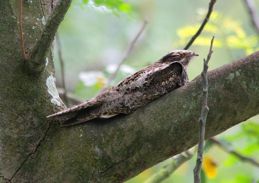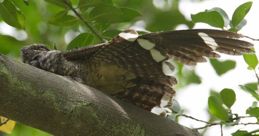On 23rd November 2007, Daniel Koh spotted a Grey Nightjar (Caprimulgus indicus), a rare passage migrant and winter visitor. The bird was perching on a large branch (left). Many birders came across the Grey on a branch, unlike the resident Large-tailed (Caprimulgus macrurus) that is usually seen on the ground. Being a perceptive birder-photographer, he noticed that the bird was sitting along the branch and not at right angle to it as with most birds. So he was curious to have a look at its feet.
As luck would have it, it was Chan Yoke Meng who managed to get a shot of the bird’s foot when it was scratching its head (below).
A nightjar’s feet are weak, as seen in the above image, as they are adapted for resting on the ground. The toes do not have the powerful grip of most other birds and presumably the bird has difficulty perching on slender branches. It is thus able to only perch on a large branch, and only sits along it.
However, this does not mean that the bird is clumsy on the ground. Many species can walk quite strongly, especially the chicks. And many occasionally feed on the ground. The toes are partly webbed and the middle toe is pectinate, as seen in herons. This is possibly used to remove parasites and straightening out the rictal bristles during preening.
Nightjars are nocturnal birds, roosting during the daylight hours. And it is during such hours that they are most vulnerable to predators. This is where their cryptic plumage comes into play, to avoid detection during the day when they are roosting.
The head appears large in relation to the body. The bill is small and appears weak. The gape is enormous and lined with long, extremely tactile, rictal bristles. These bristles are modified contour feathers whose barbs are absent. Such are the adaptations for aerial feeding.
The eyes are large and laterally placed. At night they respond to light by shining, an adaptation to improve the vision during dusk and dawn as well as during the night when the moon is absent from the sky.
Many have conspicuous white patches in the primary as well as outer-tail feathers, as seen in the Grey above, when it was stretching its wings. When the bird is resting, these white patches are never seen, becoming obvious only when in flight. These markings come into play during territorial aggression, courtship and defence displays as well as to distract predators at the nest site.
When approached, the bird may flatten itself to reduce shadow and outline, as well as close the eyes (see top image). Such behaviour provides total camouflage and it is literally unseen, especially on the ground, until you are very near, when the bird suddenly takes off with a noisy flutter.
The bird is an extremely strong flier, being provided with long, slender wings.
Daniel Koh. Ming and Melinda Chan
Singapore
January 2008
(Top image by Daniel, others by Chan Yoke Meng)












One Response